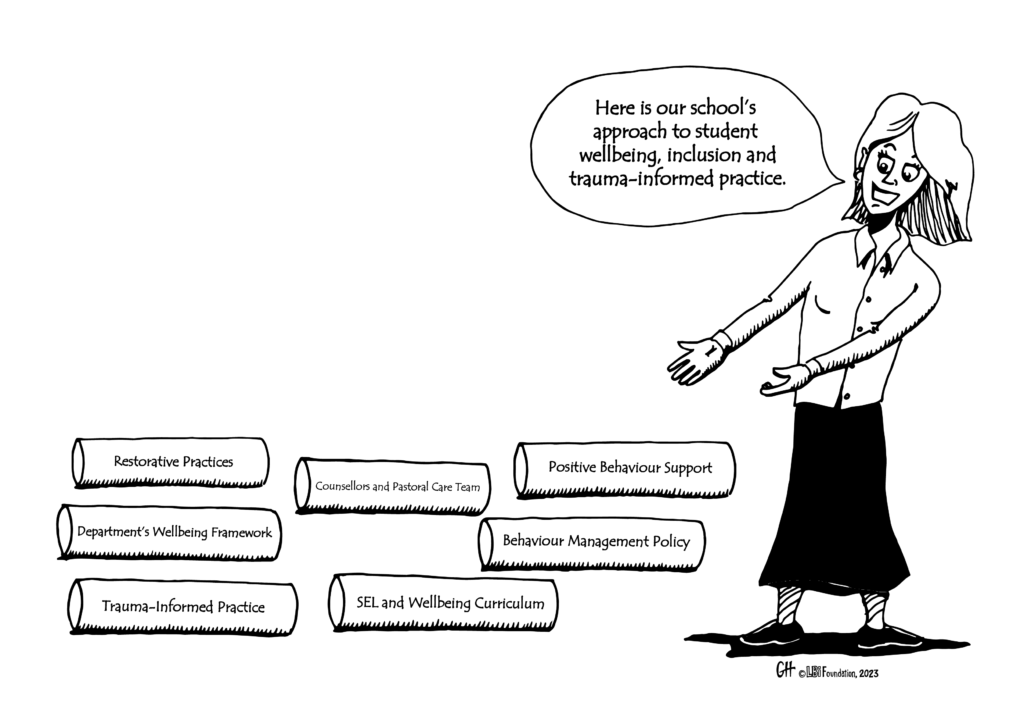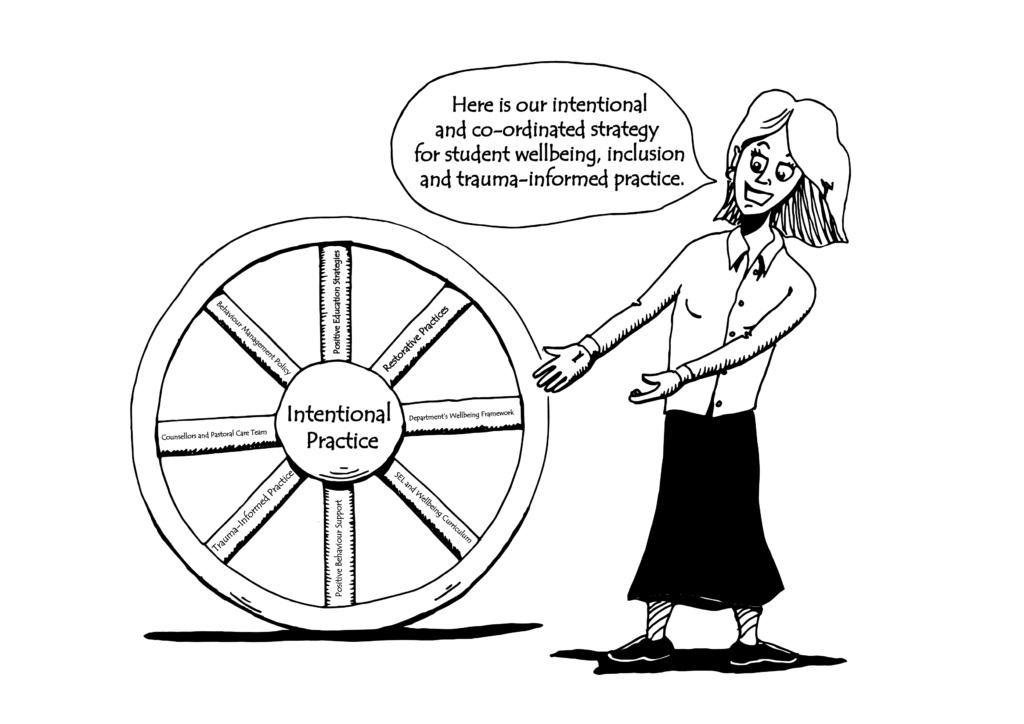Teaching and education
This page provides the applications, key considerations and critical questions of applying intentional practice across teaching and education settings.
Applications from the 'system' to the 'moment'
Intentional practice offers a shared way of thinking and planning to strengthen the delivery of wellbeing, growth, inclusion, learning, resilience and trauma-informed responses across schools and educational sites, from the ‘system’ to the ‘moment’.
Check out the video for summary applications.
Design and implementation of whole-of-school wellbeing and trauma-informed initiatives (system')
Intentional practice offers a shared way of thinking and planning to design and implement whole-of-school approaches to wellbeing, inclusion, learning and/or trauma-informed practice.
Best-practice features
Intentional practice supports the view that ‘best-practice’ whole-of-school approaches to wellbeing, learning or trauma includes:
- A clear articulation of the individual components or active ingredients of program delivery, the intent or purpose of each component and how they relate to each other (as operationalised through a logic model).
- The inclusion of a component that actions moment-to-moment support and intentional teaching. In other words, all educators are able to personalise their wellbeing and growth responses to a student’s individual needs and context.
- A clear set of values or philosophies underpinning the program or strategy.
- Growth as a practice approach, energy or intent (‘growth intent’) is visible and uplifted in action.
Critical questions for leaders
Intentional practice asks critical questions of policy makers, principals and leaders in terms of how they design and deliver whole-of-school initiatives. This includes:
- What are the active ingredients or core components of how we deliver student wellbeing or inclusion here? Have we named and identified them? Can all of our educators articulate the intent or purpose of each component, and how individual components relate and interface with each other?
- Are our social-emotional learning programs integrated within a cohesive wellbeing approach or strategy?
- Are we delivering our social-emotional learning programs with a clear intent or purpose?
- Are our counsellors, pastoral care workers and contracted clinical personnel working in alignment with the broader wellbeing/inclusion strategy.
- Do we have robust methods to deliver wellbeing and social-emotional learning content through both explicit (e.g., curriculum) and implicit (e.g., reflective conversations) processes.
- Do we have a cohesive philosophy or intent that underpins our school’s entire approach to wellbeing, inclusion and/or trauma-informed practice?
- Are we bringing enough awareness and energy to ‘growth’ as an intent or philosophy within our site? Or are we overly preoccupied with ‘managing’ student behaviour or risk?
- Do we have a method for educators to bring awareness to moment-to-moment support and teaching, where they can personalise their responses to a student’s unique wellbeing, learning and growth needs in the moment of support?
From this

To this

Student personalisation. Moment-to-moment support. Intentional teaching and SEL delivery.
Intentional practice offers a shared way of thinking and planning for educators to (1) personalise student learning, (2) provide moment-to-moment care, and (3) be intentional in their teaching and social-emotional learning (SEL) delivery.
In action
Intentional practice asks educators to:
- Bring mindful awareness to everything they do, including the needs and contexts (e.g., trauma, developmental) of students, the intent of their support, and how they are actioning this through their communication and strategies.
- ‘Respond to a student’s needs’, rather than react to a student’s surface behaviours.
- Develop a ‘shared intent’ with student, fellow educators and families.
- Support and grow students in a side-by-side manner.
- Bring a ‘growth intent’ to each and every interaction with a student, and ensure this is visible and uplifted in thinking and actions, even in crisis or when behaviour management or disciplinary processes are required.
- Intentionally deliver social-emotional learning, wellbeing and resilience content for students, drawing upon both implicit (e.g., reflective or restorative conversations, intentional coaching conversation) and explicit teaching (e.g., classroom curriculum).
- Develop personalised plans ‘for’ and ‘with’ students, and in a manner that can be actioned in moment-to-moment teaching or support.
- Apply intentional teaching and support processes.
Critical questions for educators
Intentional practice asks educators a range of critical questions (see video).
Case example: Multi school site wellbeing and learning strategy
The following video is a case example of a ‘contextualised’ approach to wellbeing and learning, developed for a multi-site alternative education program.

